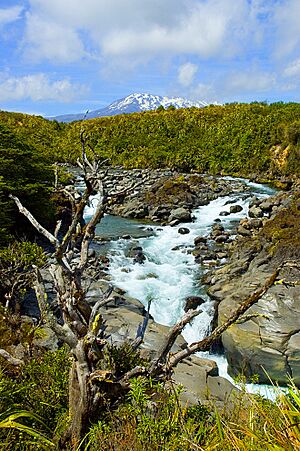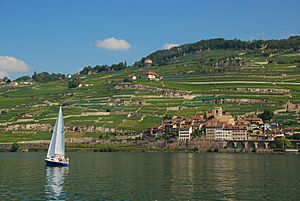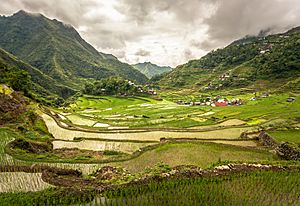Cultural landscape facts for kids
A cultural landscape is a special place where nature and human activity have mixed together over time. It's like a big artwork created by both the environment and the people living there. The World Heritage Committee describes these places as "combined works of nature and of man."
They group cultural landscapes into three main types:
- Designed landscapes: These are places humans planned and built on purpose. Think of a beautiful garden or a park.
- Evolved landscapes: These grew over time because of how people lived and worked with nature. They can be "relic" (old, no longer used) or "continuing" (still used today).
- Associative landscapes: These places are special because of their spiritual, artistic, or cultural meaning, often linked to natural features.
Contents
- How the Idea of Cultural Landscapes Grew
- Why Cultural Landscapes Are Important
- Amazing Examples of Cultural Landscapes
- Tongariro National Park, New Zealand (1993)
- Uluru-Kata Tjuta National Park, Australia (1994)
- Rice Terraces of Philippine Cordilleras (1995)
- Cultural Landscape of Sintra, Portugal (1995)
- Portovenere, Cinque Terre, and the Islands, Italy (1997)
- Hortobágy National Park, Hungary (1999)
- Matobo Hills, Zimbabwe (2003)
- Royal Botanic Gardens, Kew (2003)
- St Kilda, United Kingdom (2005)
- Lavaux Vineyard Terraces, Switzerland (2007)
- Kuk Early Agricultural Site (2008)
- West Lake Cultural Landscape of Hangzhou, China (2011)
- Qhapaq Ñan (Inca Road System), South America (2014)
- See also
How the Idea of Cultural Landscapes Grew
The idea of cultural landscapes first appeared in European landscape painting. From the 1500s, artists started painting natural scenes more than people. They showed how lands were "shaped" by nature, and these "shaped lands" became the main subject.
The word "landscape" itself comes from old German words meaning "shaped lands." It showed how people saw land as something formed by natural forces.
A geographer named Otto Schlüter was one of the first to use "cultural landscape" as an academic term in the early 1900s. He said geography should study landscapes. He described two types:
- The Urlandschaft (original landscape): This was the land before humans changed it much.
- The Kulturlandschaft (cultural landscape): This was the land shaped by human culture.
Schlüter believed geography's job was to track how these two landscapes changed over time.
Later, Carl O. Sauer, another geographer, really helped make the idea of cultural landscapes popular. He emphasized how culture actively shapes the Earth's surface. He said that the natural environment is the "medium" or tool that cultures use.
Sauer's famous definition is: "The cultural landscape is fashioned from a natural landscape by a cultural group. Culture is the agent, the natural area is the medium, the cultural landscape is the result."
Since then, many experts have used and developed the idea of cultural landscapes. In 1992, the World Heritage Committee decided to include cultural landscapes as a way to list special places that were not just natural or just cultural, but a mix of both.
Why Cultural Landscapes Are Important

The World Heritage Committee's decision to recognize cultural landscapes has led many experts and countries to identify, study, and protect these unique places. This helps make them known to the world.
Experts now see almost any place where human activity and nature interact as a cultural landscape. This is a broader idea than UNESCO's definition. It includes how people use the land, their beliefs, and traditions.
Geographer Xoán Paredes explains it this way: "... the environment modified by the human being in the course of time... It is a geographical area – including natural and cultural resources – associated to historical evolution, which gives way to a recognizable landscape for a particular human group..."
Understanding cultural landscapes is very helpful for managing and protecting our heritage in a sustainable way. It helps connect different parts of our heritage, like old buildings, local materials, and traditional building methods. This creates a stronger sense of identity for a place.
It also helps link physical heritage (like buildings) with non-physical heritage (like stories and traditions). This approach helps us manage future changes to these places. It also encourages local people to be involved in protecting their cultural heritage sites.
Some universities even offer special degrees to study cultural landscapes.
Amazing Examples of Cultural Landscapes
The World Heritage Committee has listed many areas as cultural landscapes because they are important to all humankind. Here are a few examples:
Tongariro National Park, New Zealand (1993)

In 1993, Tongariro National Park was the first place listed as a cultural landscape. The mountains in the park are very important to the Maori people. They show the spiritual connection between the Maori and their environment. The park has volcanoes, different ecosystems, and amazing views.
Uluru-Kata Tjuta National Park, Australia (1994)
This park has amazing rock formations in central Australia. Uluru, a huge rock, and Kata Tjuta, rock domes, are part of the ancient beliefs of the Anangu Aboriginal people. They are the traditional owners of this land.
Rice Terraces of Philippine Cordilleras (1995)
For 2,000 years, the Ifugao have built high rice fields that follow the shape of the mountains. This knowledge has been passed down through generations. These terraces show sacred traditions and a delicate social balance. They create a beautiful landscape that shows harmony between people and nature.
Cultural Landscape of Sintra, Portugal (1995)
In the 1800s, Sintra became a center for European Romantic architecture. King Ferdinand II turned an old monastery into a castle. He mixed Gothic, Egyptian, Moorish, and Renaissance styles. He also created a park with local and exotic trees. Other beautiful homes were built nearby, creating a unique mix of parks and gardens. This influenced landscape design across Europe.
Portovenere, Cinque Terre, and the Islands, Italy (1997)
The Ligurian coast between Cinque Terre and Portovenere is a cultural landscape with great beauty and cultural value. The small towns and the way the land is shaped, even on steep terrain, show a long history of human settlement over the last thousand years.
Hortobágy National Park, Hungary (1999)
Hortobágy National Park is Europe's largest continuous natural grassland. It wasn't formed by cutting down forests. It was Hungary's first national park, established in 1973. It is also a Biosphere Reserve and a protected wetland.
Matobo Hills, Zimbabwe (2003)
The Matobo Hills have many unique rock formations. These large boulders offered natural shelters and have been used by humans since the early Stone Age. They also have many ancient rock paintings. The Matobo Hills are still important to the local community, who use sacred places for traditional activities.
Royal Botanic Gardens, Kew (2003)
The Royal Botanic Gardens Kew (Kew Gardens) is a historic garden that shows important garden styles from the 1700s to the 1900s. Kew Gardens has plant collections (preserved plants, living plants, and documents) that are important globally. It has over 8.5 million preserved plant and fungus samples. Since 1759, the gardens have greatly helped research into plant diversity and economic botany.
St Kilda, United Kingdom (2005)
The St Kilda islands in Scotland were first listed as a natural heritage site in 1986 because of their amazing natural features and rare birds. In 2005, it was also listed as an "organically evolved relict cultural landscape." This means it's an old landscape that grew over time. It shows thousands of years of human life there.
Lavaux Vineyard Terraces, Switzerland (2007)

The Lavaux vineyard landscape clearly shows how it has changed over almost a thousand years. The well-preserved land and buildings show a long history of cultural traditions unique to this area.
Kuk Early Agricultural Site (2008)
Kuk Early Agricultural Site is in Papua New Guinea. It is one of the few places in the world where scientists have found proof of farming developing on its own. The wetlands here have archaeological evidence of farming practices going back 10,000 years.
West Lake Cultural Landscape of Hangzhou, China (2011)

The West Lake Cultural Landscape of Hangzhou includes the West Lake and the hills around it. It has inspired poets, scholars, and artists since the 800s. It has many temples, pagodas, gardens, and beautiful trees, as well as causeways and artificial islands.
Qhapaq Ñan (Inca Road System), South America (2014)
Qhapaq Ñan is a huge network of Inca roads, over 30,000 km long. The Incas built it over several centuries, using some older roads. This amazing network connected the snowy Andes mountains (over 6,000 meters high) to the coast. It went through hot rainforests, fertile valleys, and deserts. It was largest in the 1400s. The Qhapaq Ñan includes 273 sites over 6,000 km. These sites show the Incas' achievements in society, politics, building, and engineering. They also include places for trade, rest, storage, and religious sites.
See also
 In Spanish: Paisaje cultural para niños
In Spanish: Paisaje cultural para niños
- Cultural area
- Cultural geography
- Cultural region
- Ecomuseum
- Historic American Landscapes Survey
- Landscape architecture
- Lists of World Heritage Sites
- Native American use of fire
- Natural landscape
- Permanent European Conference for the Study of the Rural Landscape
- Social space




